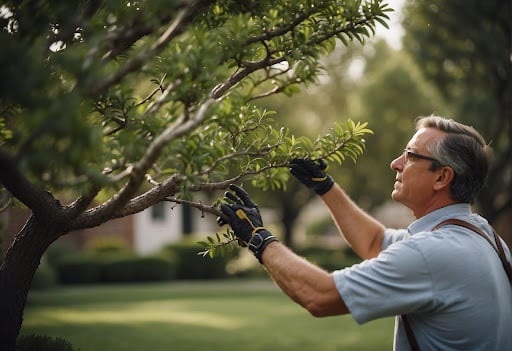Key Takeaways:
- Understanding the benefits of regular tree trimming.
- Recognizing best practices for maintaining healthy trees.
- Utilizing tree trimming for safety and improved aesthetics.
Tree pruning must be done correctly to keep the landscape looking healthy. It enhances tree growth, prevents disease, and improves overall appearance. Regular pruning ensures safety by removing dead or hazardous branches. Understanding the proper techniques and timing can help preserve tree vitality, creating a well-maintained and thriving outdoor environment.
The Importance of Regular Tree Maintenance
Tree Trimming in Locust Dale is more than just a cosmetic effort; it is a fundamental component of tree care that enhances tree health and life span. In addition to being vital components of our ecosystems, trees also significantly reduce energy use, particularly in urban settings. They emit oxygen, absorb carbon dioxide, and offer shade. Removing dead or diseased branches through regular trimming prevents decay from spreading, which could compromise the tree’s structural integrity. The practice facilitates better air circulation and optimizes sunlight exposure, crucial for photosynthesis—a process vital for tree growth and health.
Best Practices for Tree Trimming
For tree trimming to be beneficial, it must be approached strategically. Seasonality plays a role; trees should generally be pruned during their dormant season, often late winter. This timing allows for quick recovery once growth resumes in the spring. Additionally, pruning during the dormant season might reduce the likelihood of illnesses and pest infestations, which may make trees more susceptible. Employing targeted cutting techniques during this time helps reduce stress on the tree and encourages robust new growth. Since different tree species need different pruning techniques to flourish, it’s also critical to understand their unique requirements.
Enhancing Safety Through Tree Trimming
Neglected tree maintenance can turn an asset into a liability, as overgrown and unstable branches pose safety hazards, especially near power lines or buildings. Regular trimming is crucial for risk management in landscapes. By identifying and removing weakened limbs, property owners can reduce damage and enhance safety. Regular maintenance is essential to protect people and property from these risks.
Boosting Curb Appeal with Well-Maintained Trees
Beyond safety, maintaining well-trimmed trees is pivotal for enhancing curb appeal. Beautifully manicured trees can make a property more inviting and aesthetically pleasing. They provide a natural, polished look that elevates the overall landscape design. Trees tend to develop a fuller and more natural shape when branches are correctly pruned, contributing positively to the property’s ambiance. When trees are overgrown, they can block views or light from entering a home, detracting from the property’s aesthetic charm. Proper trimming can transform your yard into an attractive feature of your home environment.
How Trees Grow Healthier with Trimming
Trimming has a profound impact on tree health. It enhances a tree’s structural strength by encouraging the development of a robust branching pattern. Pruning overgrown branches allows the tree to distribute its resources better to the remaining branches, fostering stronger, healthier growth. More sunshine and airflow facilitate photosynthesis, producing energy and supporting robust growth. Regular trimming ensures that trees continue to add ecologically and aesthetically value, contributing positively to their surroundings while maintaining their health.
Choosing the Right Tools and Techniques
Effective tree trimming requires the use of the right instruments and methods. The selection of implements such as bypass pruners, loppers, and pruning saws can significantly affect the outcome of the pruning process. Clean cuts promote quick healing and reduce the likelihood of infection at the cut site. It’s essential to know the proper cutting angles and which branches to remove or retain based on the tree species and desired outcome. Proper tool maintenance, including sharpening and sterilization, is also critical to promote hygiene and efficiency in tree trimming.
Environmental Impact of Tree Trimming
The benefits of tree trimming extend beyond individual trees, impacting the broader environment positively. Healthy trees are more efficient at sequestering carbon dioxide and mitigating climate change by reducing greenhouse gases in the atmosphere. Regular tree maintenance ensures trees operate at their maximum capacity—absorbing carbon, providing oxygen, and offering shade, which helps regulate temperatures. By promoting well-being and health in trees, we contribute to broader ecological efforts to foster healthier ecosystems. Well-maintained trees are pivotal in supporting urban biodiversity and providing habitats for various creatures, such as birds and insects.
Seeking Professional Tree Services
Homeowners can perform small tree maintenance tasks, but professional services offer advantages. Arborists are trained to assess and manage tree health and safety, providing expertise, experience, and resources for precise trimming. They can conduct thorough inspections, diagnose, and implement strategies to enhance tree health and maintain aesthetic value. Professional services offer a convenient, efficient alternative to DIY approaches, providing a comprehensive solution for long-term maintenance plans.

